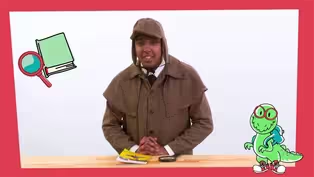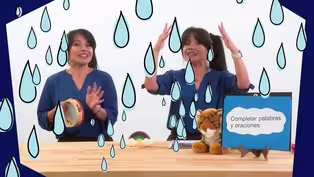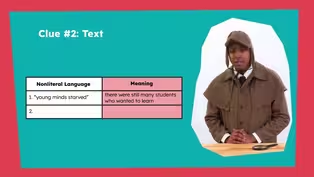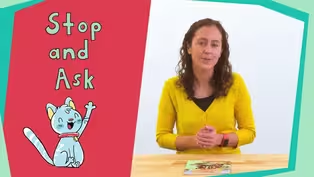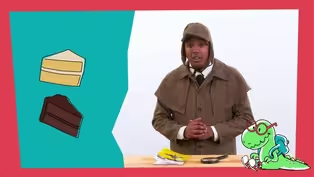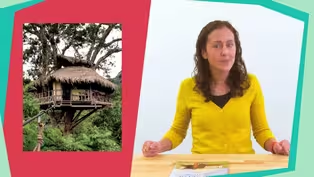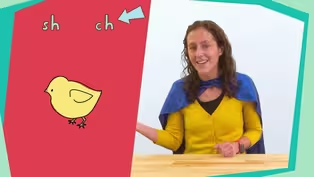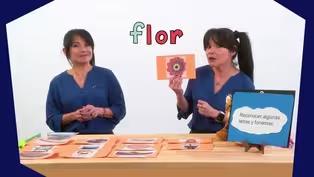
Episode 32 | Literacy Lessons
4/20/2021 | 28m 46sVideo has Closed Captions
Literacy lessons for early learners, led by NC teachers.
The first lesson (aimed at 3rd graders) explains how to compare two texts by the same author. The second lesson (aimed at PreK-K learners) helps students understand concepts of print and recognize letter Ii and its sound. Classroom Connection is your At-Home Learning companion where children love to learn. All lessons are led by NC educators.
Problems playing video? | Closed Captioning Feedback
Problems playing video? | Closed Captioning Feedback
At-Home Learning Presents: Classroom Connection is a local public television program presented by PBS NC

Episode 32 | Literacy Lessons
4/20/2021 | 28m 46sVideo has Closed Captions
The first lesson (aimed at 3rd graders) explains how to compare two texts by the same author. The second lesson (aimed at PreK-K learners) helps students understand concepts of print and recognize letter Ii and its sound. Classroom Connection is your At-Home Learning companion where children love to learn. All lessons are led by NC educators.
Problems playing video? | Closed Captioning Feedback
How to Watch At-Home Learning Presents: Classroom Connection
At-Home Learning Presents: Classroom Connection is available to stream on pbs.org and the free PBS App, available on iPhone, Apple TV, Android TV, Android smartphones, Amazon Fire TV, Amazon Fire Tablet, Roku, Samsung Smart TV, and Vizio.
Providing Support for PBS.org
Learn Moreabout PBS online sponsorshipMore from This Collection
Video has Closed Captions
Literacy lessons for early learners, led by NC teachers. (28m 46s)
Video has Closed Captions
Literacy lessons for early learners, led by NC teachers. (28m 46s)
Video has Closed Captions
Literacy lessons for early learners, led by NC teachers. (28m 45s)
Video has Closed Captions
Literacy lessons for early learners, led by NC teachers. (28m 45s)
Video has Closed Captions
Literacy lessons for early learners, led by NC teachers. (28m 46s)
Video has Closed Captions
Literacy lessons for early learners, led by NC teachers. (28m 46s)
Video has Closed Captions
Literacy lessons for early learners, led by NC teachers. (28m 45s)
Video has Closed Captions
Short Description: Literacy lessons for early learners, led by NC teachers. (28m 45s)
Video has Closed Captions
Literacy lessons for early learners, led by NC teachers. (28m 45s)
Video has Closed Captions
Literacy lessons for early learners, led by NC teachers. (28m 45s)
Video has Closed Captions
Literacy lessons for early learners, led by NC teachers. (28m 45s)
Video has Closed Captions
Literacy lessons for early learners, led by NC teachers. (28m 45s)
Providing Support for PBS.org
Learn Moreabout PBS online sponsorship[cheerful upbeat music] ♪ - Whats good my good people.
I'm Mr. R and I'm gonna be your guide on today's learning journey.
There's gonna be so twist and some turns but mostly we're gonna have some fun.
[upbeat music] - Hi, everyone.
I'm Ms. Shannon.
Sun and I are so glad you're back to learn with us again today.
This will be our last time together, so let's make it great.
We've learned a ton about the sun and how different types of texts work.
Today we'll be thinking about the words compare and contrast what comes to mind when you think of those words.
If you said similarities and differences you're on the right track.
Today we're going to read another poem about the sun called "The Sun Did Not Go Down Today" from the book "The Day the Universe Exploded My Head" by Alan Wolf.
Last time we learned the poems have important parts lines, stanzas, and rhyme schemes.
We can see that this poem has three stanzas, one, two, three, with six lines each.
One, two, three, four, five, six.
As we read, we can also listen for rhyming words since we know that many poems have a rhyme scheme.
After we read it, we're going to think about how it's alike and different from the poem we read by Alan Wolf last time which was called "The Sun, A Solar Sunnet, er, Sonnet.
Let's get started.
I'll read the new poem, stanza by stanza so we can stop and summarize to think about what it means and how the stanzas work together.
Remember that summarizing parts of a text after you read it can help you check your understanding of what the text is saying.
You can read along with me.
No matter what the poets say the sun did not go down today.
The sun did not go down today!
It only just appeared that way.
I'll tell you what the real facts is: The earth is turning on an axis!
So this stanza tells us that the sun doesn't actually go down.
It's just that the earth is spinning and tilted.
So to us on earth, it looks like the sun is going down.
This makes sense because we learned this information in the other two texts about the sun that we've explored together.
The book, "Sun, One In A Billion" and the poem, "The Sun, A Solar Sunnet".
Now I'll read the next stanza and we can think about how it builds on what we read in the first one.
Read with me.
The earth turns on its axis like a dizzy, spinning, tilted top.
Each year 365 complete rotations without stop.
And as it spins we all stand firm and ride it round with every turn This stanza gives us more detail about what we learned in the last one.
Stanza one says that the earth is turning on an axis and stanza two gives us more information about how quickly it does that.
It says that the earth spins 365 times in a year.
So stanza one, gives us a big idea then stanza two gives us smaller details about that big idea.
See how the stanza is built on one another and work together to help us understand the poem.
One more stanza.
Let's see how this one builds on the other two.
Read with me.
The sun remains there in the sky and waves at us as we go by on our spherical, miracle merry-go-round.
So next time you notice the sun going down watch in awe, but don't forget the sun stays put.
It's you who's set.
So this stanza is saying the same thing as the other two the sun stays where it is while the earth moves all around it.
And that it very clearly States the main idea that the author wants us to learn.
Even though it may look like the sun moves in the sky throughout the day, because of the spinning that we learned about in the first two stanzas, remember that it's being still.
The earth we're standing on is the actual thing moving.
Wow.
Summarizing each stanza of this poem really helped me understand the texts' main idea and how each piece of the text supports that message.
Now that we understand the main idea of this poem that the earth moves around the sun let's read it again all together.
The sun did not go down today.
No matter what the poets say the sun did not go down today!
The sun did not go down today!
It only just appeared that way.
I'll tell you what the real facts is: The earth is turning on an axis!
The earth turns on its axis, like a dizzy, spinning, tilted top.
Each year, 365 complete rotations without stop.
And as it spins, we all stand firm and ride it round with every turn.
The sun remains there in the sky and waves at us as we go by on our spherical miracle merry-go-round.
So next time you notice the sun going down watch in awe, but don't forget the sun stays put.
it's you who's set.
Awesome reading.
Remember it's always great to reread poetry because each time you read more fluently that means you read it more accurately, more expressively and with a great rhythm.
The rhyming words in the poem are a big reason why it sounds so wonderful when we read it out loud.
Last time we learned how to find a poem's rhyme scheme by labeling each line with a letter.
Let's explore this poem rhyme scheme too.
In the first stanza, the last words in the first four lines, all rhyme say today, today and way.
So they can all be labeled with the letter a.
The last words in the last two lines rhyme is and axis.
So we can label those with the letter B.
Maybe later you can find the rhyme scheme for the entire poem.
Now that we've read "The Sun Did Not Go Down Today" make sure we understood its meaning and analyze its structure.
Let's refresh our memories on the poem we read last time, The Sun, A Solar Sunnet, er, Sonnet.
That way we'll have both poems right here in our minds so we can compare and contrast them, or think of ways they're alike in different.
Read with me.
The Sun, A Solar Sunnet, er, Sonnet.
Born four and one half billion years ago.
I'm 99.8% the mass of everything the solar system knows.
My gravity holds all within its grasp.
I watched as each young planet, got its start.
I sheltered them inside my atmosphere.
I am the solar systems, burning heart the light and life of everything that's here.
I lit the fires that made you what you are when times were dark, I rose above at all.
Next time you want to wish upon a star you need not even wait for night to fall.
The simple truth may come as a surprise the closest star is right before your eyes.
Great.
Now let's think of ways that these two poems are alike and different.
When we find things that are alike, that's called comparing.
When we find things that are different that's called contrasting.
One great tool we can use to help us compare and contrast is a Venn diagram and you can see here that Venn diagrams are simply two overlapping circles.
We will put the things that are the same, about the two poems in the middle, where the two circles meet and we'll put the things that are different about the two poems off to each side.
Let's start by thinking of things that are the same.
I'll show you one and then you can help me find more.
The topic of both poems is the sun.
So that's what I'll put on the Venn diagram first.
It goes in the middle where the circles overlap.
Now, it's your turn.
I'm going to read you some lines from each poem and you tell me what they're both about.
You need not even wait for night to fall.
So next time you noticed the sun going down.
What are both of these lines referring to?
Great thinking.
They're both mentioning day changing to night.
And that makes sense because we've learned from all three texts we've read about the sun that day and night happened because the earth is spinning while going around the sun.
So in the middle part of our Venn diagram I'm going to add both say that the sun gives us day and night.
Great.
Now let's find one more similarity.
This time let's think structurally about the texts.
Both of them are what genre.
Yes, poetry.
They're both poems with lines, stanzas and rhyme schemes.
I'm going to add that.
Excellent job finding similarities.
Now let's find some differences.
Just like before I'll show you one then you can help me find two more.
For our first one, I'm noticing that though, both poems have the same topic the sun, their main ideas are different.
The main idea of the sun is that the sun is a star that holds the solar system together.
While the main idea of the sun did not go down today is that the earth spins while the sun stays still.
We can find text evidence to support both of those main ideas if we look back at the last lines of the poem.
See The Sun, A Solar Sunnet's last line says the closest star is right before your eyes.
And the last line of The Sun Did Not Go Down Today, says the sun stays put it's you who's set.
Those lines support the main ideas I just mentioned for each poem.
Main ideas are so important because they tell us what the author wants us to remember most after reading.
So I think we should definitely add those to our Venn diagram.
Now it's your turn.
I'm going to read one line to you from each poem and you think about what is different between them.
When times were dark I rose above it all.
So next time you notice the sun going down what's different about those.
Great thinking.
Though both of these lines are referring to changes that happened between night and day in The Sun a Solar Sunnet.
It's talking about the sun rising while in the sun did not go down today it mentions the sun going down.
Now we know from everything, we've read that the sun doesn't actually move, but it is interesting that both poems talk about the role of the sun in creating night and day and address it in different ways.
So let's add that.
Excellent.
Now, let's find a structural difference between these two poems or a difference in the way they're built.
We wrote in our Venn diagram similarity section that they're both poems with line, stanzas and rhyme schemes but do you also see any differences between the two poems in those areas?
Yes, the sun has four stanzas and all the stanzas don't have the same number of lines but The Sun Did Not Go Down Today has three stanzas each with six lines.
I'm going to add that.
For our last difference, let's look at the rhyme schemes of the two poems.
We wrote that they both have rhyming words in the middle but now let's think about the way their rhyme schemes differ.
You can see how we labeled the rhyme schemes of the first stanza of each column.
Look at them, are they different?
Yes.
So although both poems have rhyming words they have different rhyme schemes.
Let's add that to our Venn diagram in the correct place.
Today, we learned how to use a Venn diagram to compare and contrast two texts.
Remember to think about how texts are the same and different when you're reading on your own.
That way you can understand their topics more deeply.
Thank you for spending so much time with me and the sun.
We loved learning with you.
Bye.
All right.
One thing that really makes me happy during tough times is counting on my community.
Are there people in your community to help you?
I cannot wait to share this next video with you about the folks in our community doing good.
- I was in a sad place but art helped me to build up who I was and who I can be.
[bouncy music] [bass clarinet blows] Remember a ninth grade, I got bullied really bad to the point where rumors were spread about me that didn't even line up or make any sense.
I just didn't understand, like why can I be like them?
That's what really hurt the most 'cause I didn't know who I wanted to be.
And it just hurt me to a point where I felt like I can't do this anymore.
In my head, God told me he was like, "The only thing you can do is stand up and be a leader.
My name is Sasha, I'm 17 years old and my girl power is leadership.
I was like, wow, how am I gonna be a leader?
I don't even know how to be one.
I've never been one.
And God told me, I'll teach you.
I created a bullying prevention program.
I called it prime time because I feel like this is a time for change.
And this is a time where everything could be bright.
I see myself as sunshine.
So I was like, let me start doing art classes.
So they could actually create artwork and also get more knowledge.
At the boys and girls club in Raleigh I go there once a week and first half of the class teach them about bullying different forms of bullying, because there's a lot of them but I only teach it like to their age range.
So I teach about physical bullying, verbal, emotional and cyber bullying.
Okay.
And how could they be repeated over time?
- Like hitting you or sending me messages.
Bullies usually bully because they've been bullied too.
So I call it the bully victim.
That's why I'm teaching kids how to express their emotions with different forms of like different moves, like happiness and that.
Our project that we're doing now is what's your happiness?
[laughs] People that used to bully they come back to me, they're like your program really like helped me switch my life around.
11, if there are threats being said you need to tell your parents.
My best friend and I Dequan, we're making a website for PrimeTime.
I want my website to be a place where if anybody's confused about bullying or they're not understanding something they can find about all the forms so they can be able to understand what it is.
The sheets that I've made for my classes how would I put them up there?
I want to empower other girls to know that however they're feeling, if they feel like their voice is not being heard, that it can be.
And if they feel like they can't say it that they can use any other ways that that they feel comfortable.
Like I feel comfortable using art and I feel comfortable playing my bass clarinet so people can feel my pain because words people don't take words here.
But whenever they see it out on like a blank sheet of paper or however they want it to be they see what you're going through like, wow, they're really going through something and maybe I can change how I treat them.
Embrace your girl power.
- Today's affirmation is I am filled with kindness.
Let's fill ourselves up.
I am filled with kindness.
I am filled with kindness.
You are filled with kindness.
- Did you know that some cats are allergic to people?
I just read that.
Thank goodness I know how to read.
I guess I thought my cat just had a cold.
I better practice my reading so I can learn more about cat sneaky [sneezes] cat sneezes.
[upbeat calm music] - Hello, super learners.
My name is Mrs. Jennifer, and I'm so excited that you were here to learn with me today.
You will need a piece of paper, a pencil and a stuffed animal for today's lesson.
Ask a trusted adult to help you find these items while you're getting your supplies I'm gonna grab mine.
I'll be right back.
[upbeat music] Okay, I'm back now and I see you are too.
We have our supplies so let's go.
Today we are gonna read a story about a mother pig who can't find her piglets.
We will review the parts of a book, review the letters P and G and learn the letter I.
We will also learn about some animals.
Let's get started.
The last time we were together we use a circle map to help us think about the letter P and some words that begin with the p sound.
We named pepperoni pizza, puppy, paint brush, and a pickle.
We also use the circle map to think about the letter G and some words that begin with the g sound.
We named grapes, gate, and green grass.
Now we are gonna learn about the letter I, the letter I looks like this.
We write it by starting at the top and making a straight line down then we jump back to the top and make a straight line that goes from left to right then we're gonna jump down to the bottom and make another line that goes from left to right.
Let's all get out our magic finger and write the letter I in the air.
Start at the top, make a straight line down, then jump back to the top and make a straight line that goes from left to right then jump down to the bottom and make another line from left to right.
The letter I makes this sound eh.
Say it to your stuffed friend, eh, eh, eh.
Now turn it, say it to me, eh.
Good job, saying the eh sound.
We're gonna use a graphic organizer called the circle map to help us think about the letter I and the things that begin with it sound eh.
You can make your own circle map using a piece of paper and a pencil crayons.
First, you draw a small circle on your map then you're gonna write what you think or what we're thinking about in the small circle.
Today we're thinking about the letter I so we should write the letter I in the small circle.
So again, start at the top, make our straight line down, then go back to the top, make our line from left to right then at the bottom, make another line from left to right.
Then we're gonna draw our big circle around our small circle.
Now you have a circle map.
Super learners, I need your help so that we can fill in the circle map with things that begin with the sound eh.
I will give you a clue and you try to guess what I'm thinking of.
Are you ready?
Great.
I am thinking of an animal that is only one inch long.
It moves by sliding its body together stretching it back out.
Can you tell your stuffed friend what I am thinking of.
Did you say inch farm?
That's right.
Great thinking.
Can you show your stuffed friend how to move like an inchworm?
Now I'm gonna write the word inchworm on the circle map.
Hmm inch worm.
What is the first sound ehn the word inchworm?
That's right, i.
Which letter do we need to spell that sound?
That's right we spell the sound eh with the letter i then we need N-C-H-W-O-R-M. That spells inchworm.
Now I am thinking of an animal that lives in trees.
It is green and eats plants.
Can you tell your stuffed friend what I'm thinking of?
Did you say iguana?
That's great.
Great thinking.
Can you show your friend how to eat plants like an iguana?
[chewing] Now, I'm gonna write the word iguana on the circle map.
Hmm iguana.
What is the first sound of the word iguana?
That's right?
i.
Which letter do we need to spell that sound?
That's right.
We spell the sound eh with the letter I, then we need G-U-A-N-A that spells iguana.
Wow, super learners our circle map looks great.
Look at those i words we know.
Thanks for helping.
Now, let's get ready to read our book.
Here is our book.
It is titled "Little Piglets".
A book has several parts.
This part is called the front cover.
It has the title, tell us the author and illustrator and has a picture to show us what the story is about.
This is the back cover.
When we open our book the very first page we come to is called the title page.
We call this page, the title page because it has the title on it.
Tell your friend what is a title page?
Say the title is the name of the book.
Do you see the title?
Look at me and say the title is the name of the book.
In this story, mother pig has lost her piglets.
I remember when I lost my favorite purple pen I looked everywhere.
I was so sad when I couldn't find it.
Then I went to write in my notebook and there it was, I was so happy.
Have you ever lost anything?
What happened when you lost it?
How did you feel when you couldn't find it?
How did you feel when you found it?
Tell your stuffed friend what happened when you lost something?
[upbeat calm music] Oh, wow.
Now let's turn our page and see what happens when mother pig can't find her piglets.
As we are reading let's count the animals we see in the story.
"Where are my piglets," says mother pig.
"I will look for them."
Mother pig looks by the pond.
She sees little ducklings.
Let's count them.
One, two, three, but her little piglets are not there.
Mother pig looks by the house.
She sees little chicks.
Let's count them.
One, two, three better.
But her piglets are not there.
Mother pig looks by the gate.
She sees little lambs.
Let's count them.
One, two, but her little piglets are not there.
Mother pig looks by the barn.
She sees little kittens.
Let's count them.
One, two, three, but her little piglets are not there.
Then mother pigs sees five little pink tails and mother pigs sees her little piglets.
Let's count them.
One, two, three, four, five.
That's great.
I am so glad that mother pig found her piglets.
Are you?
Wow.
We counted a lot of little animals, tell your stuffed friend how many animals you counted?
Great counting.
All right super learners that is the end of our lesson for today.
Thank you so much for being with me as we reviewed the letters, P and G, and learned about the letter I. I hope you enjoyed the story about mother pig and her search for her piglets.
Keep looking for words that begin with the letters P, I, and G, when you find new P, I, and G words add them to your circle maps.
I'll see you next time.
[pop sounds] [lighthearted music] - [Narrator] Once upon a time an imagine friend felt different from his peers.
So he began trying to be like the other imagine friends hoping to fit in.
And he was never really happy.
One day superhero friend noticed him looking upset and went to talk to him.
After hearing his story, superhero friend reminded him of all of the great things that everyone loves about him including the qualities that make him different.
Superhero friend is very enthusiastic and kind.
He's always there to remind his friends to love themselves and be whoever they want to be.
- Sometimes I feel dizzy after practicing math.
Do you ever feel that way?
It can be overwhelming to learn so much.
Our teachers know that it can be difficult to learn sometimes and everyone learns at a different pace and learning is not a race.
Learning is more like being in a parade.
You know, everyone comes together, gathers to celebrate and we all move forward to get to a new place by the end.
Some people might get to the end sooner but it doesn't mean that they're bad.
There are so many cool things happening at all parts of the parade, not just the front.
So learn at your pace and enjoy the ride.
[cheerful upbeat music] ♪
Support for PBS provided by:
At-Home Learning Presents: Classroom Connection is a local public television program presented by PBS NC
